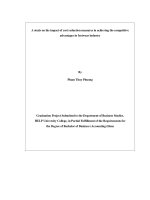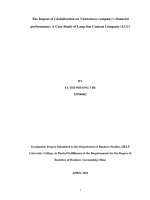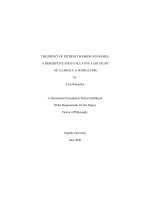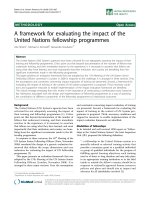A statistical study on the impact of rain water harvesting on groundwater levels and farming economy
Bạn đang xem bản rút gọn của tài liệu. Xem và tải ngay bản đầy đủ của tài liệu tại đây (270.96 KB, 7 trang )
Int.J.Curr.Microbiol.App.Sci (2019) 8(4): 906-912
International Journal of Current Microbiology and Applied Sciences
ISSN: 2319-7706 Volume 8 Number 04 (2019)
Journal homepage:
Original Research Article
/>
A Statistical Study on the Impact of Rain Water Harvesting on
Groundwater Levels and Farming Economy
K.S. Shwetha*, K.V. Ashalatha, A.R.S. Bhat and Tanveer Ahmed Khan
Department of Agricultural Statistics, College of Agriculture, UAS, Dharwad, India – 580005
*Corresponding author:
ABSTRACT
Keywords
Rainwater
harvesting,
Correlation,
Backward
regression, t-test,
cropping intensity,
B:C ratio etc.
Article Info
Accepted:
10 March 2019
Available Online:
10 April 2019
The present investigation was carried out in Dharwad Taluk (Karnataka) during 20072008, to evaluate the influence of weather parameter on ground water level and the impact
of Rain Water Harvesting on farming economy. Monthly data on weather parameters and
ground water level recorded by District Statistical Office, Main Research Station Dharwad
and Department of Mines and Geology Dharwad respectively for 28 years were collected.
Primary data were collected from the randomly selected 60 sample farmers of both with
and without Rain Water Harvesting Systems. Data related to year 2007-2008 were elicited
using pre-structured and pre-tested schedules. The results of the analysis indicated that the
ground water was significantly correlated with rainfall (positively) and temperature
(negatively). The study indicated that the farmers of with RWHS were found to have
positive impact on land holding, cropping intensity. Investment of farmers of with RWHS
indicated favorable results in terms of B: C ratio.
ground, lakes, rivers and atmosphere and is
useful to mankind. Whereas, more than 99 per
cent of water present on the earth is not useful
to agriculture (Anonymous, 2003).
Introduction
Water is an essential and precious resource
upon which our ecosystem and agriculture
production depend. However, water a natural
resource of the world, constitutes 1,384
million cubic kilometers of which around
97.39 per cent (i.e. 1,348 million cubic
kilometers) is in the oceans. Another 2.61 per
cent (i.e., 36 million km3) is fresh water of
this 77.23 per cent (27.82 million km3) is in
polar ice caps, icebergs and glaciers. Only
small fraction of water resources (0.59% or
8.2 million km3) of the earth is present in the
Mounting population pressure, increasing
concerns of food and nutrition security and
environmental safety make natural resources
management a key strategy towards achieving
sustainability in dry land agriculture. Rainfed
agriculture contributes about 44 percent of the
total food grain production in the country and
supports 40 percent of the population
(Chandracharan et al., 2007). Rainwater is the
906
Int.J.Curr.Microbiol.App.Sci (2019) 8(4): 906-912
essential input in dry land agriculture.
Rainfall is the principle source of
replenishment of moisture in the soil through
infiltration process and subsequent recharge
to the ground water through deeper
percolation. In India, approximately 24
million hectare meter equivalent runoff is
available for harvesting and many indigenous
and improved water harvesting practices are
available to utilize the runoff. From the above
facts it is evident that there is a considerable
scope to undertake a statistical impact study
of rain water harvesting. Even though Sujala
watershed efforts at farm level water
harvesting schemes are wide spread in
Karnataka, the impact is not fully explored.
Due to this reason the present study was
designed with the objective to know the
impact of weather parameter on ground water
levels and rain water harvesting structures on
economy of the farmers.
parameters viz., rainfall, relative humidity,
wind speed and temperature were determined
by using Karl Pearson’s correlation
coefficient. Coefficient of determination (R2)
is used as the measure of explanatory value of
the model. Based on the R2, model of best fit
to the data was selected. In case of multiple
regressions, ground water level was
considered as dependent variable and
independent variables were rainfall, relative
humidity, wind speed and temperature. To
determine the contribution of each
independent variable to the ground water
level, backward regression technique was
carried out, where the variables which
contribute least to the dependent variable are
eliminated one by one. Statistical packages
like SPSS 15.0 and curve expert were used for
correlation and regression analysis. To
compare the socio economic features of the
farmers with and without RWHS the two
sample independent t-test is carried out to test
the null hypotheses on land holdings. The
paired t test was used to analyze the impact of
rain water harvesting structures on
productivities of major crops among sample
farmers. Impact of RWHS on Cropping
intensity was calculated to measure the
intensity of cropping in time and space
dimensions i.e. in case of mono cropping CI
is always 100% and in case of multiple
cropping it is more than 100% (Arun
Katyayan, 2001). The benefit cost ratio of the
cropping pattern of the sample farmers was
analysed to compare the gross benefits to the
total costs to determine the economical
condition of the sample farmers.
Materials and Methods
The required data for the present study
included both secondary and primary data.
Secondary data on weather parameters viz.,
rainfall, relative humidity (RH), wind speed
and temperature were collected from District
Statistical Office (DSO) and Main Research
Station (MRS) Dharwad. The data on ground
water level was collected from Department of
Mines and Geology, Dharwad. Monthly data
on weather parameters and ground water level
for 28 years were collected. The primary data
on household compositions, land holdings,
cropping pattern, social behavior etc were
collected from the randomly selected 60
sample farmers of both with and without
RWHS. Primary data related to agriculture
year 2007-2008 in Managundi and Mansur
sub watersheds of Dharwad taluk were
elicited using prestructured and pre tested
schedules.
Results and Discussion
Impact of weather parameters on ground
water level
Correlation coefficient between ground water
level and different weather parameters were
calculated which is presented in Table 1 in the
form of correlation matrix. The ground water
The degree of relationships between ground
water level and each of the weather
907
Int.J.Curr.Microbiol.App.Sci (2019) 8(4): 906-912
level was significant and positively correlated
with rainfall (0.618) and was negatively
correlated with temperature (-0.401). Rest of
the parameters i.e. relative humidity and wind
speed were not significantly correlated with
ground water level with correlation
coefficient 0.348 and 0.237 respectively. The
results of the correlation analysis of weather
parameter and ground water level gain
support from the study conducted by
Muralidharan et al., (2007), who observed
that rise in water level yielded an exponential
relation indicating that daily rainfall
exceeding 40mm/day results in significant
rise in ground water level.
Impact of Rain Water Harvesting systems
on farming economy
Majority of the farmers belonged to large
farmers category (Table 5) in case of with
RWHS(63.33%)
and
without
RWHS
(46.67%) followed by small farmers. The
average land holdings observed was almost
same (2.54 ha and 2.02 ha) in both areas. The
difference in the land holding of the farmers
of both adopters and non-adopters group was
found not significant. The land holdings of
the farmers before and after adoption of
RWHS were compared an the difference in
land holding was found highly significant
(1%) (Table 6). This indicates that the area of
cropping or the increase in yield in case of
either of the group is due to impact of RWHS
not because of land holdings or the farmers
brought more area under cultivation after
adopting the RWHS because of the
availability of moisture even in the rabi
season. This study conformed to earlier
findings by Jahagirdar (1991), who observed
that during 1985-86 to 1990-91, the cultivated
area of the farmers belonging to watershed
area increase in both Kharif and rabi season.
The multiple regression model fit was found
highly significant (1%) for the data with
R2=0.44.The results are presented in Table 2
and coefficient of significance is presented in
Table 3. Out of the four weather parameters
only rainfall was contributing significantly to
ground water level. Even though temperature
was contributing significantly when taken
individually, in presence of other variable it
was not found significant. The result was in
conformity with the findings of Sreekanth
(2009), who reported that, a reliable
forecasting model for predicting the ground
water level using weather parameter through
ANN (Artificial Neural Network) was proved
to be the best fit with R2 =0.93.
It is evident from the Table 7 that the gross
cropped area was more in case of with RWHS
(104.36 ha) area compared to without RWHS
(64.8 ha) area mainly because of better
conservation residual moisture in the rabi
season due to construction of RWHS. As a
result cropping intensity enhanced (128.09%)
in case of RWHS area. The results gain
support from the study conducted by Neema
et al., (1991) Desai et al., (2007) and other
who observed that the adoption of in situ
moisture conservation technique has resulted
in decline of the area under waste land and
helps in increasing the cropping intensity.
The contribution of each weather parameters
to the ground water level using backward
regression technique is presented in Table 4.
Regression model for predicting the ground
water level based on rainfall was found better
by eliminating the other variables i.e, wind
speed, relative humidity, temperature one by
one. In this model only rainfall was retained
which is contributing to the ground water
level and R2 was found to be 0.38 (Fig. 1).
This indicates that rainfall plays a major role
in predicting ground water level followed by
temperature.
The results presented in Table 8 revealed
better idea about the differences in crop
productivities of various crops of with and
without RWHS areas by virtue of
908
Int.J.Curr.Microbiol.App.Sci (2019) 8(4): 906-912
implementation of RWHS. The net crop yield
in with RWH area over without RWH area
was more in case of paddy (7.05q/ha)
followed
by maize
(6.23q/ha)
and
soybean(5.16q/ha) with percentage change of
40.17%, 28.29% and 36.41% respectively. It
could be inferred that percentage increase of
crop productivity obtained by the farmers
with RWHS was considerably higher over
without RWHS area. The result is in
conformity with the findings of Singh and
Rahim (1990) and Chandracharan et al.,
(2007) reported that due to increased soil
moisture and increased area under kharif and
rabi that positively lead to increase in the crop
yields.
Table.1 Correlation between the Ground water level and weather parameters
Parameters
Ground Water
level
Ground
Water level
1
Rainfall
Relative
Humidity
0.348
(0.069)
0.258
(0.185)
0.618**
(0.000)
1
Rainfall
Relative
Humidity
Wind Speed
Temperature
Wind Speed
Temperature
0.237
(0.225)
0.242
(0.215)
0.112
(0.570)
1
-0.401*
(0.034)
-0.311
(0.107)
0.586**
(0.001)
-0.145(0.463)
1
1
Note: ** Significance at 1%;
* Significance at 5%;
Figures in parentheses indicate probability level
Table.2 ANOVA for multiple regression
Sources of
variation
Regression
Residual
Total
df
4
23
27
Sum of
squares
70.48
92.97
163.46
Mean sum of
squares
17.62
4.04
F
Significance
4.35
0.009
Table.3 Model summary for multiple regressions
Co-efficient
Variables
Constant
Rainfall
Relative humidity
Wind speed
Temperature
B
24.15
0.07**
0.04
0.19
-1.057
SE
39.42
0.002
0.076
0.358
1.443
** Significance at 1%; Dependent variable is Ground water level
Multiple regression equation for ground water level and weather parameter
Y = 24.15 + 0.007**X1 + 0.04X2 + 0.19X3 – 1.057X4
with R2 = 0.44
X1: Rainfall;
X2: Relative humidity
X3: Wind speed;
X4: Temperature
909
t
0.613
2.980
0.535
0.536
0.733
Int.J.Curr.Microbiol.App.Sci (2019) 8(4): 906-912
Table.4 Backward regression model for ground water level and weather parameter
Model
Start
1
2
3
Variables Entered
Temp, WS, RF, RH
Temp, RF, RH
Temp, RF
RF
Variables Removed
WS
WS, RH
Temp, WS, RH
R2
0.44
0.43
0.43
0.38
Significance
0.007
0.003
0.001
0.00045
Table.5 Classification of sample farmers according to their land holdings
Farmer’s type
Sl.no
With RWHS
Frequency
Percentage
Without RWHS
Frequency Percentage
1.
Marginal ( < 1 hectare)
2
6.67
3
10.00
2.
Small (1 to 2 hectares)
9
30.00
13
43.33
3.
Large (> 2 hectares)
19
63.33
14
46.67
4.
Total
30
100.00
30
100.00
5.
Average land holding (ha)
2.54
2.02
Table.6 Comparison of the land holdings and impact of RWHS on beneficiaries and nonbeneficiaries
Particulars
Non adopters
Non adopters
Before RWHS
After RWHS
After adoption of RWHS
Mean ± sd
t-value
2.02±0.86
1.52 NS
2.54±1.66
2.02±1.47
2.54±1.66
4.85**
NS: Non significance; **Significant at 1%
Table.7 Impact of RWHS on cropping intensity of the sample farmers
Particulars
Gross cropped area
(hectares)
Net cropped area
(hectares)
Cropping intensity (%)
With RWHS
104.36
Without RWHS
64.8
81.47
60.64
128.09
106.86
910
Int.J.Curr.Microbiol.App.Sci (2019) 8(4): 906-912
Table.8 Impact of rain water harvesting on productivities of major crops
Crops
With RWHS
Without RWHS
24.60
28.25
16.75
19.33
15.34
16.63
6.52
4.89
17.55
22.02
12.83
14.17
11.25
13.50
4.34
3.33
Paddy
Maize
Jowar
Soybean
Cotton
Ground nut
Horse gram
Green gram
(Q/hectares)
% Change in crop yield over without RWHS
area
7.05 (40.17)
6.23 (28.29)
3.92 (30.55)
5.16 (36.41)
4.09 (36.35)
3.13 (23.18)
2.18 (50.23)
1.56 (46.84)
Figures in parentheses indicates percentages to total
Table.9 Cost and return profile of the crops of sample farmers
(Rs. Per Ha)
Sl.No
Total gross returns
Total cost
B:C ratio
With RWHS
14048.08
6683.44
2.10
Without RWHS
10247.36
6727.57
1.52
Fig.1 Diagrammatic representation of the important characters and r2 value included in
backward regression model
0.44
0.43
0.43
0.38
A critical observation of cost and returns
structure (Table 9) revealed that the cost of
cultivation was more in case of without
RWHS area. However, returns were more in
case of with RWHS area as compared to
without RWHS area. The B:C ratio was more
than unity in both the cases. But the returns
per rupee of cost were observed more for the
farmers of with RWHS as compared to
farmers of without RWHS. The above
findings were supported by the study
conducted by Naidu (2001), Singh and Gupta
(1991), who noticed that the watershed
projects gave positive net returns throughout
the period.
911
Int.J.Curr.Microbiol.App.Sci (2019) 8(4): 906-912
Karnataka J. Agric. Sci., 20 (2):426427.
Jahagirdar, D V., 1991, Manoli watershed
development project – A case study of
some growth parameters. Indian J. of
Agric. Econ., 46 (3): 304.
Muralidharan,
D.,
Rolland
Andrade.,
Rangarajan. R., 2007, Evaluation of
check-dam recharge through water-table
response in ponding area. Curr.sci., 92
(10): 1350-1352.
Naidu, A., 2001, Evaluation of land and water
resources and socioeconomic impact
assessment of Vanjuvankal watershed in
Ananthpur district of Andhra Pradesh,
India. Environment and People, 8(1): 37.
Neema, M.G., Singh, V.N. and Mishra, B.L.,
1991, Impact of Barkheda – Hat
Watershed development Programme in
district of Guna of Madhya Pradesh.
Indian J. Agric. Econ., 46(3): 305-306.
Singh, B. V., and Gupta, D. D., 1991, Impact
of watershed based farming system on
crop productivity and socio-economic
status- A case study of Bunga project,
Haryana. Indian Journal of Agricultural
Economics, 46(3): 304 – 305.
Singh, K. and Rahim, K.M.B., 1990,
Identification and evaluation of optimal
cropping system for a typical watershed
in Uttar Pradesh hills. Indian J. Agric.
Econ.,, 45(1): 29-35.
Sreekanth, P. D., Geethanjali, N., Sreedevi, P.
D., Shakeel Ahmed, Ravi Kumar, N.,
and Kamala Jayanthi, P.D., 2009,
Forecasting Groundwater level using
artificial neural networks. Curr. Sci.,
96(7): 933-939.
Policy implication
The prediction model showed the positive and
similar trends in groundwater level and
rainfall. This response will be higher in
watershed areas where water is continuously
available for groundwater recharge till the
pond becomes dry. Therefore in order to
increase the groundwater recharge and
moisture conservation, farmers need to be
encouraged to follow the adoption of
rainwater harvesting structures
under
watershed technology. Watershed technology
has helped in augmenting returns from
dryland agriculture. RWHS were found to
have positive impact on cropping intensity,
productivity, favourable returns in terms of
B:C ratio. Hence farmers need to be
encouraged to follow this technology
particularly in the areas where ground water
level has declined.
References
Anonymous, 2003, National water policy of
water resource. Government of India
New Delhi, www.watermgmt.com/
en/index.htm.
Arun Katyayan., 2001, Fundamentals of
agriculture. Vol-.1. Kushal Publications
and Distributors, Varanasi.
Chandracharan,
V.,
Syed
Sadaqath.,
Hirevenkanagoudar, Chandargi, D M.,
2007, Adoption of watershed practices
by the repsondents of Sujala watershed.
Karnataka J. Agric.Sci.,20(1):176-177.
Desai Rajeshwari., Patil., B. L., Kunnal, L.B.,
Jayashree, H. Basavaraj, H., 2007,
Impact assessment of farm-ponds in
Dharwad
district
of
Karnataka.
How to cite this article:
Shwetha, K.S., K.V. Ashalatha, A.R.S. Bhat and Tanveer Ahmed Khan. 2019. A Statistical
Study on the Impact of Rain Water Harvesting on Groundwater Levels and Farming Economy.
Int.J.Curr.Microbiol.App.Sci. 8(04): 906-912. doi: />
912









